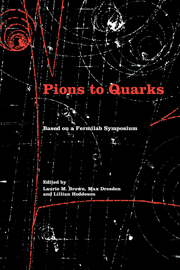Book contents
- Frontmatter
- Contents
- List of contributors
- Foreword by Leon M. Lederman
- Editors' acknowledgments
- Photographs of the symposium
- List of abbreviations
- List of notation
- I Introduction
- II Particle discoveries in cosmic rays
- III High-energy nuclear physics
- IV The new laboratory
- V The strange particles
- VI Weak interactions
- VII Weak interactions and parity nonconservation
- VIII The particle physics community
- IX Theories of hadrons
- 39 The early S-matrix theory and its propagation (1942–1952)
- 40 From field theory to phenomenology: the history of dispersion relations
- 41 Particles as S-matrix poles: hadron democracy
- 42 The general theory of quantized fields in the 1950s
- 43 The classification and structure of hadrons
- 44 Gauge principle, vector-meson dominance, and spontaneous symmetry breaking
- X Personal overviews
- Name index
- Subject index
39 - The early S-matrix theory and its propagation (1942–1952)
Published online by Cambridge University Press: 07 May 2010
- Frontmatter
- Contents
- List of contributors
- Foreword by Leon M. Lederman
- Editors' acknowledgments
- Photographs of the symposium
- List of abbreviations
- List of notation
- I Introduction
- II Particle discoveries in cosmic rays
- III High-energy nuclear physics
- IV The new laboratory
- V The strange particles
- VI Weak interactions
- VII Weak interactions and parity nonconservation
- VIII The particle physics community
- IX Theories of hadrons
- 39 The early S-matrix theory and its propagation (1942–1952)
- 40 From field theory to phenomenology: the history of dispersion relations
- 41 Particles as S-matrix poles: hadron democracy
- 42 The general theory of quantized fields in the 1950s
- 43 The classification and structure of hadrons
- 44 Gauge principle, vector-meson dominance, and spontaneous symmetry breaking
- X Personal overviews
- Name index
- Subject index
Summary
Introduction
Study of the formation and propagation of S-matrix theory in the 1940s helps one to understand the rapid development, under radically different scientific and sociological conditions, of the theory of elementary particles in the fifties. The S matrix is a two-dimensional array whose elements are the transition amplitudes between states of atomic or elementary particle systems. According to a standard textbook of the midfifties, “Such a scattering matrix was first introduced by Wheeler (1937) in connection with the problems of nuclear structure and scattering. It has been reinvestigated in great detail by Heisenberg (1943) in connection with the theory of elementary particles.” During World War II and the first postwar years, few people were interacting on problems of pure physics; only on rare occasions, often accidentally, did they meet for discussions, or even exchange letters. Despite these obstacles, they did interesting and original work that led to the resumption of particle physics by a larger group after World War II. The S matrix played a comparatively large role in the discussions around 1945, but was abandoned in the early fifties. Toward the end of the fifties, however, several developments led to renewed interest in it.
The origin of the S-matrix theory of elementary particles
In a paper submitted in the summer of 1937, John A. Wheeler proposed to derive the properties of light nuclei, such as energy levels and transition probabilities, with the help of a unitary “scattering matrix.” The elements of this matrix were connected with the transition from incoming to outgoing groups, consisting of a few protons and neutrons within the nuclei in question.
- Type
- Chapter
- Information
- Pions to QuarksParticle Physics in the 1950s, pp. 551 - 578Publisher: Cambridge University PressPrint publication year: 1989
- 4
- Cited by



